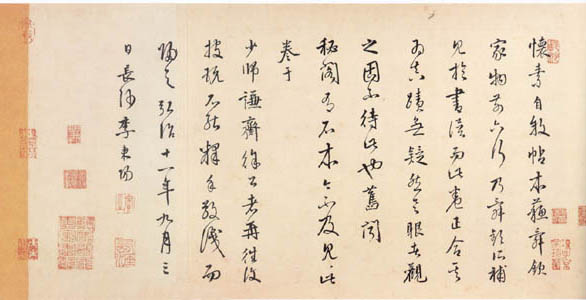Li Dongyang (1447-1516), courtesy name Binzhi and alias Xiya, was born in Chaling, Huguang (now Chaling, Hunan). He has been studying Chinese writing since he was a child. When he was in the capital with his father at the age of 4, he could write the diameter of Daeyu, and he was regarded as a child prodigy. Because of his talent and reputation, he was summoned by Jing Zong three times when he was four, six and eight years old. When he was eight years old, he chose to study in Shuntian Prefecture. Li Dongyang passed the imperial examination at the age of sixteen. In the second year, he passed the Jinshi examination. From then on, his career went smoothly. At the age of eighteen, he was elected as a scholar of the Hanlin Academy. In the eighth year of Chenghua (1472), he served as editor and editor of the Hanlin Academy. In the 16th year of Chenghua (1480), 34-year-old Li Dongyang served as lecturer of the Hanlin Academy and as examiner of the Tianfu (Nanjing) rural examination. In the sixth year of Hongzhi (1493), he served as a bachelor of the Hanlin Academy. In the seventh year of Hongzhi (1494), Li Dongyang served in the cabinet and was responsible for imperial edicts. Later, he served as the right minister of the Ministry of Rites, the minister of the Ministry of Rites, the Ministry of Husbandry, the Ministry of Personnel, and the bachelor of Wenyuan Pavilion, Jinshen Palace, and Huagai Palace. Li Dongyang was a famous politician and writer in the Ming Dynasty. The poems are elegant and beautiful, and the influence of his poems formed the "Chaling Poetry School".
Li Dongyang is good at seal script, official script, regular script, running script and cursive script. He was a calligrapher during the transition period from Taige style calligraphy in the early Ming Dynasty to Wumen calligraphy in the mid-Ming Dynasty. He was quite proud of his seal script and said to himself: "After Li Si and Li Yangbing, I will be considered a minor." He was one of the few seal script calligraphers in the Ming Dynasty and had a certain influence on the seal writing of the Ming Dynasty. His regular calligrapher, Fayan Zhenqing, was strict in his rules and his style was clear and unrestrained. He captured the essence and became his own style. He was the forerunner of Wu sect calligraphy. His cursive and cursive scripts incorporate the legacy of seal script and official script, and his writing style is different from that of other cursive calligraphers in the Ming Dynasty. He has achieved the highest achievement in this aspect, especially cursive script. Shine and form your own style. Li Dongyang's calligraphy has broken away from the constraints of the Taige style in the early Ming Dynasty and played a role in inheriting the calligraphy style in the mid-Ming Dynasty. Representative works include: Seal script "Huai Su's Self-narrative Notes", regular script "Sui'an Ming", cursive script "Self-written Poems", etc. He is the author of "Huailutang Collection", "Shihua" and "Yan Duilu".
Wang Shizhen of the Ming Dynasty said: "Ya Weng's seal script is better than the ancient official script, and the ancient official script is better than truth, line, and grass." Zhan Jingfeng's "Zhan's Xiaobian" of the Ming Dynasty said: "Dongyang cursive script has a strong and vigorous writing style, and the small seal script is clear and powerful." When I came to my hometown, I asked those who wrote poems and seal scripts to fill the threshold, hoping to get his calligraphy treasures.

Attached: Coda to Huai Su’s autobiography








